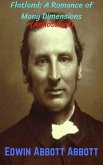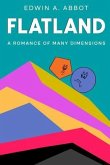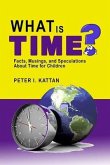This special edition is a distinguished vintage reproduction, of the 1884 satirical novella Flatland, by the English schoolmaster Edwin Abbott. Meticulously elaborated by the editorial team of Chiron Academic Press in collaboration with the renowned literature publisher Edition l'Aleph (www.l-aleph.com), this special edition, pays particular attention to the very authentic details of the editorial of text and images, fine type setting, mise-en-page, production, and print. The result is a revival of the vintage for the 21st century's reader. Thus a unique reading experience for the book lovers and collectors of this genre. A recommended edition to libraries.
Writing pseudonymously as "A Square", the book used the fictional two-dimensional world of Flatland to comment on the hierarchy of Victorian culture, but the novella's more enduring contribution is its examination of dimensions. The story describes a two-dimensional world occupied by geometric figures, whereof women are simple line-segments, while men are polygons with various numbers of sides. The narrator is a square, a member of the caste of gentlemen and professionals, who guides the readers through some of the implications of life in two dimensions. The Square dreams about a visit to a one-dimensional world (Lineland) inhabited by "lustrous points", and attempts to convince the realm's monarch of a second dimension; but is unable to do so. . .
"One of the most imaginative, delightful and, yes, touching works of mathematics, this slender 1884 book purports to be the memoir of A. Square, a citizen of an entirely two-dimensional world." -The Washington Post Book World
"Flatland has remained of interest for over a century precisely because of its ability to engage its readers on so many different planes in so many different dimensions."-Victorian Studies "This reprint of Abbott's Flatland adventures contains an Intro¬duction by Thomas Banchoff which is worth reading on its own. So if you don't have yet this book at home, go ahead and buy this edition."-Zentralblatt MATH
In 1884, Edwin Abbott wrote a strange and enchanting novella called Flatland, in which a square who lives in a two-dimensional world comes to comprehend the existence of a third dimension but is unable to persuade his compatriots of his discovery. Through the book, Abbott skewered hierarchical Victorian values while simul¬taneously giving a glimpse of the mathematics of higher dimensions.-Science News
Writing pseudonymously as "A Square", the book used the fictional two-dimensional world of Flatland to comment on the hierarchy of Victorian culture, but the novella's more enduring contribution is its examination of dimensions. The story describes a two-dimensional world occupied by geometric figures, whereof women are simple line-segments, while men are polygons with various numbers of sides. The narrator is a square, a member of the caste of gentlemen and professionals, who guides the readers through some of the implications of life in two dimensions. The Square dreams about a visit to a one-dimensional world (Lineland) inhabited by "lustrous points", and attempts to convince the realm's monarch of a second dimension; but is unable to do so. . .
"One of the most imaginative, delightful and, yes, touching works of mathematics, this slender 1884 book purports to be the memoir of A. Square, a citizen of an entirely two-dimensional world." -The Washington Post Book World
"Flatland has remained of interest for over a century precisely because of its ability to engage its readers on so many different planes in so many different dimensions."-Victorian Studies "This reprint of Abbott's Flatland adventures contains an Intro¬duction by Thomas Banchoff which is worth reading on its own. So if you don't have yet this book at home, go ahead and buy this edition."-Zentralblatt MATH
In 1884, Edwin Abbott wrote a strange and enchanting novella called Flatland, in which a square who lives in a two-dimensional world comes to comprehend the existence of a third dimension but is unable to persuade his compatriots of his discovery. Through the book, Abbott skewered hierarchical Victorian values while simul¬taneously giving a glimpse of the mathematics of higher dimensions.-Science News
Dieser Download kann aus rechtlichen Gründen nur mit Rechnungsadresse in A, D ausgeliefert werden.









